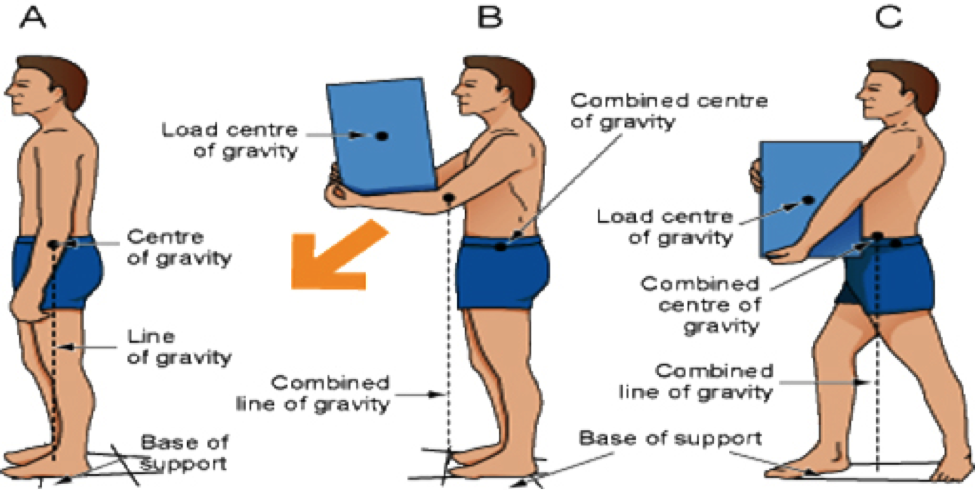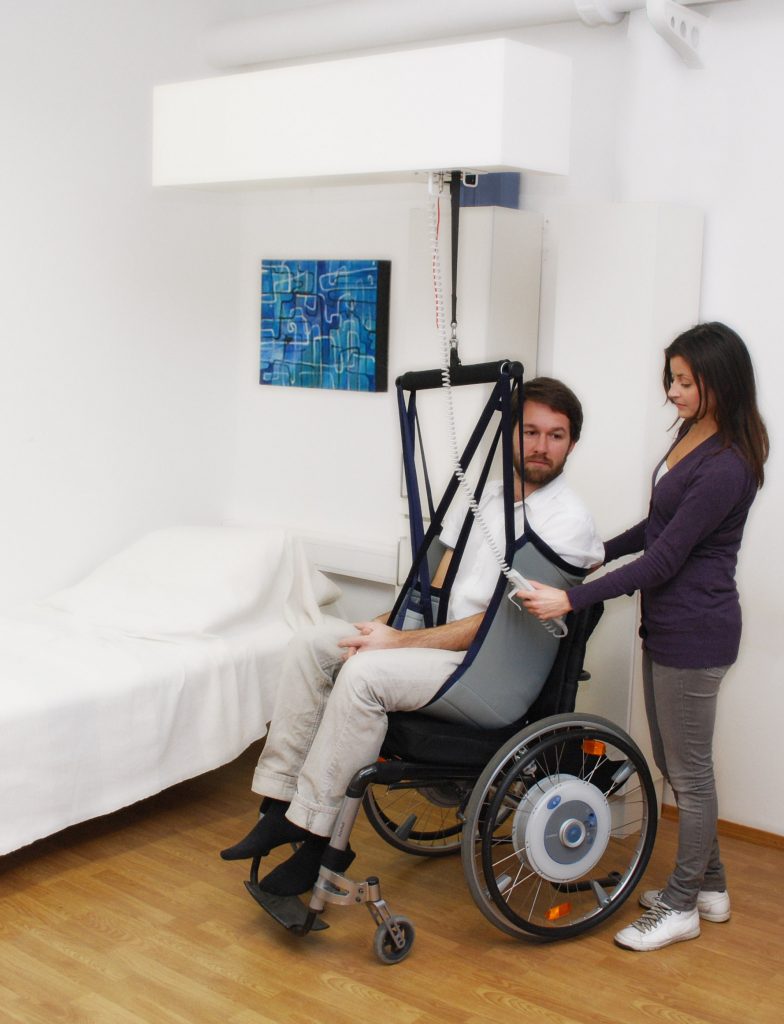3.4 Body Mechanics and Safe Equipment Use
In addition to promoting safety for patients and their families, it is important for health care workers to be aware of safety risks in the environment and to take measures to protect themselves. Common safety risks to health care workers include sharps injuries, exposure to blood-borne pathogens, lack of personal protective equipment, and lifting injuries. A sharps injury is a penetrating wound from a needle, scalpel, or other sharp object that may result in exposure to blood-borne pathogens. Blood-borne pathogens are pathogenic microorganisms present in blood and body fluids that can cause disease such as hepatitis B (HBV) and human immunodeficiency virus (HIV). Personal protective equipment (PPE) is used to prevent transmission of blood-borne pathogens and infection and includes gloves, masks, goggles, gowns, and other types of protective equipment. This section will focus on lifting injuries related to moving clients, and the other safety risks will be discussed in Chapter 4.
The health and well-being of nurse aides is directly related to the quality of care residents receive. When a health care worker is injured, they may be unable to provide care to the extent required by residents. With this in mind, it is vital for nursing assistants to know how to prevent injury in the workplace. An article published in the 2018 International Journal of Environmental Research and Public Health noted that 88% of nurse aides reported at least one of their body parts having a work-related musculoskeletal symptoms (WRMS).[1] The lower back was the most commonly affected WRMS area, followed by the arms and shoulders. According to this study, nursing assistants ranked first for occupational-related back sprains and strains, above construction workers, garbage collectors, and other health care workers. WRMS reported by nurse aides account for over 50% of all musculoskeletal injuries reported in the United States. These injuries are attributed to manual handling of clients, lifting heavy physical loads, assuming frequent awkward positions, and performing repetitive movements.[2]
Using gait belts and mechanical lifts for transferring residents from one location to another, such as from the bed to a wheelchair or a wheelchair to the toilet, has greatly reduced the risk of lifting injuries to both residents and aides. These transferring techniques will be discussed in Chapter 8.
Lifting injuries can also occur when repositioning residents while they are in bed. Repositioning is frequently performed for residents to provide hygiene, alleviate pain, or prevent skin breakdown. The ABC mnemonic for using proper body mechanics when transferring or repositioning residents stands for Alignment, Base of support, and Center of gravity[3]:
- Alignment: Correct body alignment is also referred to as good posture. When standing up straight, an imaginary line should be able to be drawn straight down through the center of the body so that both sides of the body are mirror images of each other. Body parts should be lined up naturally, with arms at one’s side, palms directed forward, and feet pointed forward and slightly apart. Follow these guidelines to use proper alignment to prevent lifting injuries:
- Maintain correct body alignment when lifting or carrying an object.
- Keep the object close to your body, unless close proximity could transmit pathogens.
- Point your feet and body in the direction you are moving.
- Do not twist at the waist.
- Base of support: Creating a good base of support improves your balance, whereas imbalance creates awkward positioning that can lead to injury. To create a strong base of support, place your feet about shoulder width apart or just slightly wider than your hips.
- Center of gravity: A person’s center of gravity is where most of one’s weight is concentrated. When standing, the pelvis is the center of gravity. Maintaining a low center of gravity provides a stable base of support and improves balance.
For example, when lifting objects or people, keep your center of gravity low with a good base of support by bending at the knees with the feet shoulder width apart. Keep in mind that your center of gravity also includes the resident or the object, so keep them as close to your body as possible. To maintain good alignment, face the person or object you are moving and use both sides of your body equally. Figure 3.7[4] illustrates safer body mechanics in Option “C” by maintaining good alignment, establishing a base of support, and keeping the load close and near to one’s center of gravity while bending the knees.

Facilities have specialized equipment used to assist in lifting and transferring clients that significantly reduces the risk of lifting injuries. Manufacturers provide specific instructions for the safe use and maintenance of their equipment. Be certain that you receive extensive training on safely using this equipment during your orientation to the facility. Orientation to lifting equipment should include becoming familiar with all parts of the device, the requirements for the mobility status of residents who will use that device, and potential risks to residents and caregivers while using the device. See Figure 3.8[5] for an image of lifting equipment.

For additional information on OSHA regulations for using lifting equipment and preventing lifting injuries, refer to this document: Guidelines for Nursing Homes PDF.
- Cheung, K., Szeto, G., Lai, G., & Ching, S. (2018). Prevalence of and factors associated with work-related musculoskeletal symptoms in nursing assistants working in nursing homes. International Journal of Environmental Research and Public Health, 15(2), 265. https://doi.org/10.3390/ijerph15020265 ↵
- Cheung, K., Szeto, G., Lai, G., & Ching, S. (2018). Prevalence of and factors associated with work-related musculoskeletal symptoms in nursing assistants working in nursing homes. International Journal of Environmental Research and Public Health, 15(2), 265. https://doi.org/10.3390/ijerph15020265 ↵
- North Carolina Department of Health and Human Services. (2019). State-approved curriculum: Nurse aide I Training program. https://info.ncdhhs.gov/dhsr/hcpr/curriculum/pdf/moduleI.pdf ↵
- “Centre_of_Gravity.png” by Glynda Rees Doyle and Jodie Anita McCutcheon is licensed under CC BY 4.0. Access for free at https://opentextbc.ca/clinicalskills/chapter/3-2-body-mechanics/ ↵
- “User-Integra-lifter1.jpg” by Integracp is licensed under CC BY-SA 3.0 ↵
A penetrating wound from a needle, scalpel, or other sharp object that may result in exposure to blood-borne pathogens.
Pathogenic microorganisms present in blood and body fluids that can cause disease such as hepatitis B (HBV) and human immunodeficiency virus (HIV).
Equipment used to prevent transmission of blood-borne pathogens and infection, including gloves, masks, goggles, gowns, and other types of protective equipment.
Symptoms from musculoskeletal injuries experienced at work, such as lower back pain, that are attributed to manual handling of clients, heavy physical loads, frequent awkward positions, and repetitive movements.

